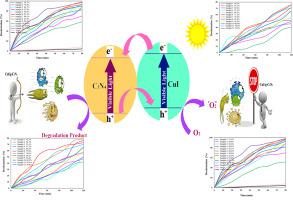Ecotoxicology and Environmental Safety ( IF 6.8 ) Pub Date : 2020-11-28 , DOI: 10.1016/j.ecoenv.2020.111712 Mojgan Ghanbari , Masoud Salavati-Niasari

|
The photocatalytic process is an environmentally-friendly procedure that has been well known in the destruction of organic pollutants in water. The multiple semiconductor heterojunctions are broadly applied to enhance the photocatalytic performances in comparison to the single semiconductor. Polymeric semiconductors have received much attention as inspiring candidates owing to their adjustable optical absorption features and simply adaptable electronic structure. The shortcomings of the current photocatalytic system, which restricts their technical applications incorporate fast charge recombination, low-utilization of visible radiation, and low immigration capability of the photo-induced electron-hole. This paper indicates the novel fabrication of new CuI/g-C3N4 nanocomposite by hydrothermal and ultrasound-assisted co-precipitation methods. The structure, shape, and purity of the products were affected by different weight percentages and fabrication processes. Electron microscope unveils that CuI nanoparticles are distributed on g-C3N4. The bandgap of pure carbon nitride is estimated at 2.70 eV, and the bandgap of the nanocomposite has increased to 2.8 eV via expanding the amount of CuI. The CuI/C3N4 nanocomposite has a great potential to degrade cationic and anionic dyes in high value because of its appropriate bandgap. It can be a great catalyst for water purification. The photocatalytic efficiency is affected by multiple factors such as types of dyes, fabrication methods, the light sources, mass ratios, and scavengers. The fabricated CuI/C3N4 nanocomposite exposes higher photocatalytic performance than the pure C3N4 and CuI. The photocatalytic efficiency of nanocomposite is enhanced by enhancing the amount of CuI. Besides, the fabricated CuI/C3N4 revealed remarkable reusability without the obvious loss of photocatalytic activity. The antibacterial activity of the specimens reveals that the highest antimicrobial activities are revealed against P. aeruginosa and E. coli. These results prove that the nanocomposite possesses high potential for killing bacteria, and it can be nominated as a suitable agent against bacteria.
中文翻译:

碘化铜修饰的石墨氮化碳片,具有增强的可见光响应,可去除光催化的有机污染物和抗菌活性
光催化过程是一种环境友好的程序,在破坏水中有机污染物方面众所周知。与单个半导体相比,多个半导体异质结被广泛应用以增强光催化性能。高分子半导体因其可调的光吸收特性和简单的适应性电子结构而成为激发灵感的候选者。当前的光催化系统的缺点限制了它们的技术应用,包括快速的电荷复合,可见光的利用率低以及光诱导电子空穴的低迁移能力。本文指出了新型CuI / gC 3 N 4的新颖制备方法纳米复合材料的水热和超声辅助共沉淀方法。产品的结构,形状和纯度受重量百分比和制造工艺的影响。电子显微镜揭示,CuI纳米颗粒分布在gC 3 N 4上。纯氮化碳的带隙估计为2.70 eV,并且通过扩展CuI的量,纳米复合材料的带隙已增加到2.8 eV。CuI / C 3 N 4纳米复合材料具有合适的带隙,因此具有很高的降解阳离子和阴离子染料的潜力。它可以作为净化水的绝佳催化剂。光催化效率受多种因素影响,例如染料的类型,制造方法,光源,质量比和清除剂。所制备的CuI / C 3 N 4纳米复合材料比纯C 3 N 4和CuI具有更高的光催化性能。通过增加CuI的量可以提高纳米复合材料的光催化效率。此外,制造的CuI / C 3 N 4显示出显着的可重用性,而光催化活性没有明显损失。标本的抗菌活性表明,对铜绿假单胞菌和大肠杆菌的抗菌活性最高。这些结果证明该纳米复合材料具有杀死细菌的高潜力,并且可以被提名为抗细菌的合适试剂。


























 京公网安备 11010802027423号
京公网安备 11010802027423号